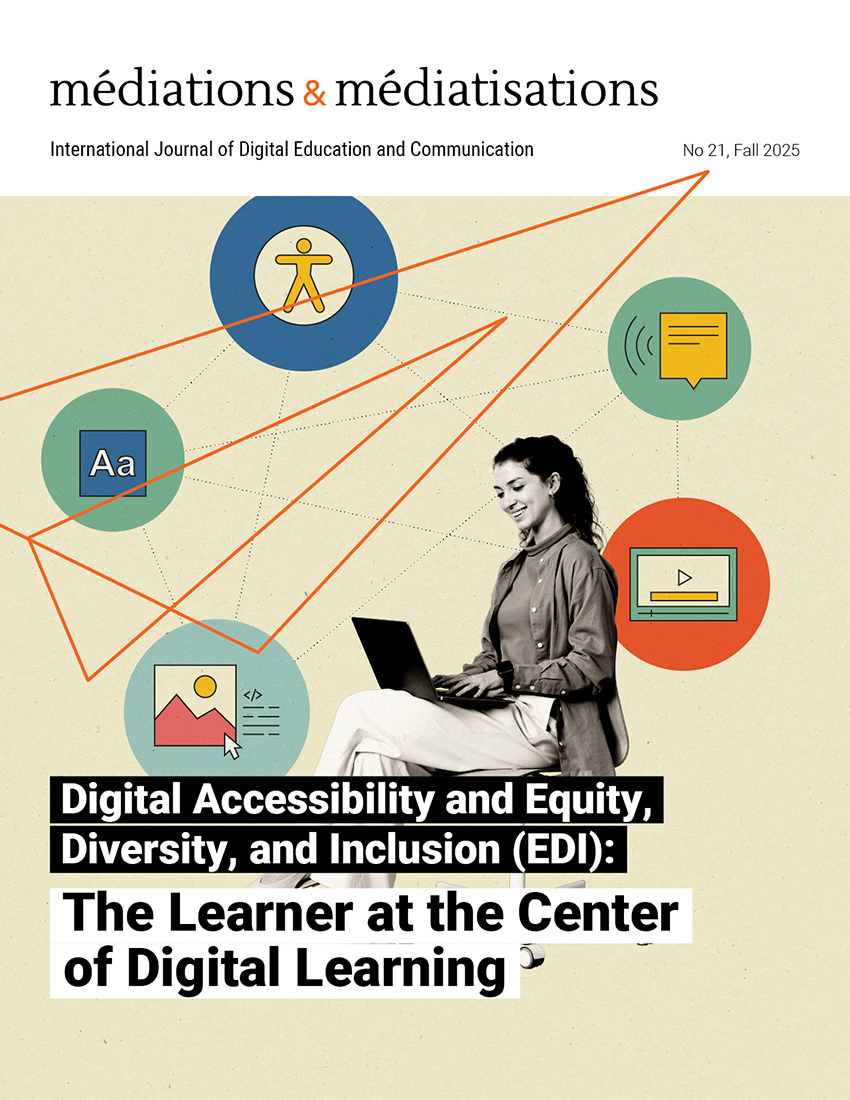From Generalized Accessibility to Reasoned Inclusion: A Critical Analysis of a University Digital Environment
Main Article Content
Abstract
Twenty years after passing the 2005 law on equality and citizenship for people with disabilities, this article analyzes digital accessibility in higher education, particularly for students with specific learning disabilities. Drawing on the example of the University of Orléans, it highlights the progress made as well as the limitations of an often technocentric approach, illustrated by questionable choices. The article advocates for reasoned accessibility centered on user experience, taking individual needs into consideration. It underscores the tensions between generalized accessibility and targeted inclusion, calling for a complementary approach that balances individual accommodations and collective adaptations. Reconciliation lies in fostering inclusion education for all university stakeholders, avoiding specific profile invisibilization and ensuring equitable accessibility based on scientific evidence and human mediation.
Downloads
Article Details

This work is licensed under a Creative Commons Attribution-NonCommercial-ShareAlike 4.0 International License.
References
Bacquelé, V. (2019). L’expertise enseignante au défi de l’usage des ordinateurs en classe par des élèves dyslexiques. La nouvelle revue – Éducation et société inclusives, 87(3), 61-74. http://doi.org/10.3917/nresi.087.0061 DOI: https://doi.org/10.3917/nresi.087.0061
Ebersold, S. (2009). Inclusion. Recherche et formation, (61), 71-83. DOI: https://doi.org/10.4000/rechercheformation.522
Fougeyrollas, P., Entretien conduit par Ferez, S. et Torterat, F. (2024). Construire une école plus inclusive. Carrefours de l’éducation, (58), 93-103. https://doi.org/10.3917/cdle.058.0093 DOI: https://doi.org/10.3917/cdle.058.0093
Leonova, T. et Grilo, G. (2009). La faible estime de soi des élèves dyslexiques : mythe ou réalité? L’Année psychologique, 109(3), 431-462. https://doi.org/10.3917/anpsy.093.0431 DOI: https://doi.org/10.3917/anpsy.093.0431
Loi n° 2005-102 du 11 février 2005 pour l’égalité des droits et des chances, la participation et la citoyenneté des personnes handicapées (1). 2005-102 (2005). France. https://www.legifrance.gouv.fr/dossierlegislatif/JORFDOLE000017759074/
Ministère chargé de l'Enseignement supérieur et de la Recherche (2024). 16 Les étudiants en situation de handicap dans l’enseignement supérieur. Repères et références statistiques. État de l'Enseignement supérieur, de la Recherche et de l'Innovation en France no18. https://publication.enseignementsup-recherche.gouv.fr/.
Ministère de l'Éducation nationale, de l'Enseignement supérieur et de la Recherche (2025). Les projets numériques territoriaux : Les espaces numériques de travail (ENT). https://www.education.gouv.fr/les-projets-numeriques-territoriaux-les-espaces-numeriques-de-travail-ent-450478
Norwich, B. (2014). Recognising value tensions that underlie problems in inclusive education. Cambridge Journal of Education, 44(4), 495-510. DOI: https://doi.org/10.1080/0305764X.2014.963027
Plaisance, É. (2019). Le numérique par et pour l’éducation inclusive. Numérique et éducation inclusive. Quelles alliances? Conclusion du dossier. La nouvelle revue - Éducation et société inclusives, 87(3), 165-176. https://doi.org/10.3917/nresi.087.0165. DOI: https://doi.org/10.3917/nresi.087.0165
Université d’Orléans (2018). Schéma directeur pluriannuel du handicap (SDH) 2018-2022. https://www.univ-orleans.fr/upload/public/2021-06/SDH%202018%2022%20fe%CC%81vrier%202018.pdf
Wery, J. J., et Diliberto, J. A. (2016). The effect of a specialized dyslexia font, OpenDyslexic, on reading rate and accuracy. Annals of Dyslexia, 66(1), 1-14. https://doi.org/10.1007/s11881-016-0127-1 DOI: https://doi.org/10.1007/s11881-016-0127-1

